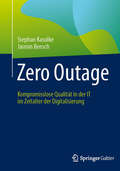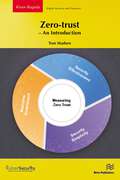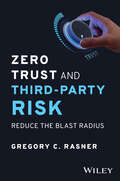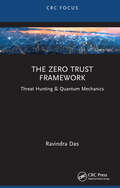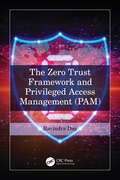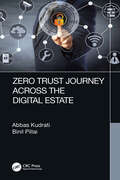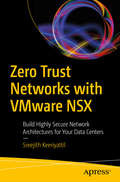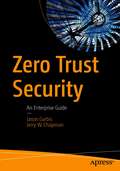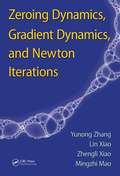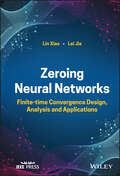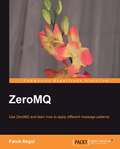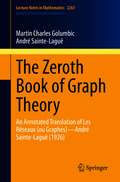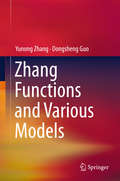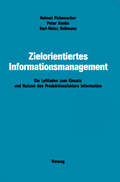- Table View
- List View
Zero Outage: Kompromisslose Qualität in der IT im Zeitalter der Digitalisierung
by Stephan Kasulke Jasmin Bensch Ferri AbolhassanDas Fachbuch zeigt, wie die Zero-Outage-Methode zu mehr Stabilität im Betrieb, mehr Zuverlässigkeit in Projekten und letztlich zu einer größeren Kundenzufriedenheit führt. Es verdeutlicht, weshalb klare Standards bei Plattformen, Prozessen und Personal unverzichtbar sind, um eine hohe ICT-Qualität von Ende zu Ende sicherzustellen und worauf es bei Changes – den häufigsten Ursachen für IT-Ausfälle – ankommt. Zudem erfahren die Leser, wie man Störungen schnellstmöglich behebt und dauerhaft abstellt und warum die Zusammenarbeit von ICT-Anbietern künftig nur mit einem gemeinsamen Qualitätsstandard gelingen kann. So dient dieses Buch als praxisnahe Anleitung, die eigene ICT-Welt noch ausfallsicherer und leistungsfähiger zu machen. Dazu teilen die Autoren ihre wichtigsten Erkenntnisse im Qualitätsmanagement und geben einen exklusiven Einblick in ihr – über viele Jahre erprobtes und kontinuierlich weiterentwickeltes – Erfolgsrezept: den Zero-Outage-Ansatz.
Zero to Hero in Cryptocurrency Trading: Learn to trade on a centralized exchange, understand trading psychology, and implement a trading algorithm
by Bogdan VaidaGo from the bare basics to implementing your own automatic trading algorithm and become a cryptocurrency trading proKey FeaturesExcel at crypto trading with structured methodologies, practical examples, and real-time trading scenariosGo from the theoretical know-how to developing and testing your own strategyTransform manual trades into an automated algorithm for nonstop tradesPurchase of the print or Kindle book includes a free PDF eBookBook DescriptionIn today's fast-paced digital age, cryptocurrencies have emerged as a revolutionary financial asset class, capturing the attention of investors and traders worldwide. However, navigating the world of cryptocurrency trading can be overwhelming for beginners. Zero to Hero in Cryptocurrency Trading acts as a guiding light to navigate this complex realm. This comprehensive guide to cryptocurrency trading empowers you to go from a novice trader to a proficient investor by helping you implement your own trading strategy. As you progress, you’ll gain structured trading knowledge through hands-on examples and real-time scenarios, bolstered by trading psychology and money management techniques. You’ll be able to automate your manual trades with an algorithm that works even while you sleep. You’ll also benefit from interactive teaching methods, including screenshots, charts, and drawings to help decode market operations and craft your unique edge in the dynamic crypto world. As an added bonus, you’ll receive ready-to-use templates to identify useful indicators, test your strategy, and even maintain a trading journal. By the end of this book, you’ll be well-equipped to trade cryptocurrencies and automate manual trading to give you an edge in the markets.What you will learnMaster trading psychology and prevent emotions from sabotaging tradesManage risks by identifying and tailoring specific risk profilesInterpret, assess, and integrate technical indicators in your tradingGet to grips with trading on a centralized exchangeGet a deeper understanding of risk and money managementGain an edge by identifying trading patternsAutomate the patterns into a strategy for a bot that operates 24/7Who this book is forThis book is for finance and investment professionals, crypto market enthusiasts, and anyone new to trading who wants to kickstart their cryptocurrency trading journey. A basic understanding of cryptocurrencies is a must, but prior trading experience is not necessary.
Zero-trust – An Introduction (River Publishers Rapids Series in Digital Security and Forensics)
by Tom MadsenThe book provides you with information on how to implement and manage a zero-trust architecture across these different layers of an infrastructure. It is an introduction to the overall purpose of zero-trust and the benefits that zero-trust can bring to an infrastructure, across many different technologies: Cloud Networking Identity management Operational Technology (OT) 5G Zero-trust is not a product, but a way of thinking about design and architecture. Cisco and Microsoft are used as the technology vendors, but the steps and information are equally applicable to other technology vendors.
Zero-trust – An Introduction (River Publishers Rapids Series in Digital Security and Forensics)
by Tom MadsenThe book provides you with information on how to implement and manage a zero-trust architecture across these different layers of an infrastructure. It is an introduction to the overall purpose of zero-trust and the benefits that zero-trust can bring to an infrastructure, across many different technologies: Cloud Networking Identity management Operational Technology (OT) 5G Zero-trust is not a product, but a way of thinking about design and architecture. Cisco and Microsoft are used as the technology vendors, but the steps and information are equally applicable to other technology vendors.
Zero Trust and Third-Party Risk: Reduce the Blast Radius
by Gregory C. RasnerDramatically lower the cyber risk posed by third-party software and vendors in your organization In Zero Trust and Third-Party Risk, veteran cybersecurity leader Gregory Rasner delivers an accessible and authoritative walkthrough of the fundamentals and finer points of the zero trust philosophy and its application to the mitigation of third-party cyber risk. In this book, you’ll explore how to build a zero trust program and nurture it to maturity. You will also learn how and why zero trust is so effective in reducing third-party cybersecurity risk. The author uses the story of a fictional organization—KC Enterprises—to illustrate the real-world application of zero trust principles. He takes you through a full zero trust implementation cycle, from initial breach to cybersecurity program maintenance and upkeep. You’ll also find: Explanations of the processes, controls, and programs that make up the zero trust doctrine Descriptions of the five pillars of implementing zero trust with third-party vendors Numerous examples, use-cases, and stories that highlight the real-world utility of zero trustAn essential resource for board members, executives, managers, and other business leaders, Zero Trust and Third-Party Risk will also earn a place on the bookshelves of technical and cybersecurity practitioners, as well as compliance professionals seeking effective strategies to dramatically lower cyber risk.
Zero Trust and Third-Party Risk: Reduce the Blast Radius
by Gregory C. RasnerDramatically lower the cyber risk posed by third-party software and vendors in your organization In Zero Trust and Third-Party Risk, veteran cybersecurity leader Gregory Rasner delivers an accessible and authoritative walkthrough of the fundamentals and finer points of the zero trust philosophy and its application to the mitigation of third-party cyber risk. In this book, you’ll explore how to build a zero trust program and nurture it to maturity. You will also learn how and why zero trust is so effective in reducing third-party cybersecurity risk. The author uses the story of a fictional organization—KC Enterprises—to illustrate the real-world application of zero trust principles. He takes you through a full zero trust implementation cycle, from initial breach to cybersecurity program maintenance and upkeep. You’ll also find: Explanations of the processes, controls, and programs that make up the zero trust doctrine Descriptions of the five pillars of implementing zero trust with third-party vendors Numerous examples, use-cases, and stories that highlight the real-world utility of zero trustAn essential resource for board members, executives, managers, and other business leaders, Zero Trust and Third-Party Risk will also earn a place on the bookshelves of technical and cybersecurity practitioners, as well as compliance professionals seeking effective strategies to dramatically lower cyber risk.
The Zero Trust Framework: Threat Hunting & Quantum Mechanics
by Ravindra DasThe Cybersecurity landscape is a daunting one today. It is nothing like it was 10 years ago. Now, it has become very complex, covert, dynamic, and stealthy. It has literally become a cat and mouse game, in which the Cyberattacker is still one step ahead. This is despite all of the technology that is available to us a society, which includes Artificial Intelligence (AI) and Machine Learning. Part of the other problem is that human beings are resistant to change. For example, the password is still the favored way of authenticating and authorizing an individual, but it too has shown its grave limitations. Despite the use of Password Managers, which can create long and complex passwords, people still resort to their old fashioned ways of doing things. So what is needed now is an extreme change, in which, unfortunately, people have no choice in whether or not they will participate. It is called the Zero Trust Framework, and in this methodology, absolutely nobody can be trusted in either the internal or the external environments. The mantra here is to keep verifying everybody, all the time. The Zero Trust Framework also involves the concept of segmentation, in which the IT and Network Infrastructure of a business is broken down into smaller components, much like a Subnet. Each component will have its own layer of security, and every individual must be authenticated via the use of Multifactor Authentication (MFA). In this book, we review both the concepts and mechanics behind the Zero Trust Framework. We also introduce advanced technologies into it, including the use of Biometrics, the Public Key Infrastructure, and Quantum Mechanics/Quantum Cryptography.
The Zero Trust Framework: Threat Hunting & Quantum Mechanics
by Ravindra DasThe Cybersecurity landscape is a daunting one today. It is nothing like it was 10 years ago. Now, it has become very complex, covert, dynamic, and stealthy. It has literally become a cat and mouse game, in which the Cyberattacker is still one step ahead. This is despite all of the technology that is available to us a society, which includes Artificial Intelligence (AI) and Machine Learning. Part of the other problem is that human beings are resistant to change. For example, the password is still the favored way of authenticating and authorizing an individual, but it too has shown its grave limitations. Despite the use of Password Managers, which can create long and complex passwords, people still resort to their old fashioned ways of doing things. So what is needed now is an extreme change, in which, unfortunately, people have no choice in whether or not they will participate. It is called the Zero Trust Framework, and in this methodology, absolutely nobody can be trusted in either the internal or the external environments. The mantra here is to keep verifying everybody, all the time. The Zero Trust Framework also involves the concept of segmentation, in which the IT and Network Infrastructure of a business is broken down into smaller components, much like a Subnet. Each component will have its own layer of security, and every individual must be authenticated via the use of Multifactor Authentication (MFA). In this book, we review both the concepts and mechanics behind the Zero Trust Framework. We also introduce advanced technologies into it, including the use of Biometrics, the Public Key Infrastructure, and Quantum Mechanics/Quantum Cryptography.
The Zero Trust Framework and Privileged Access Management (PAM)
by Ravindra DasThis book is about the Zero Trust Framework. Essentially, this is a methodology where the IT/Network Infrastructure of a business is segmented into smaller islands, each having its own lines of defense. This is primarily achieved through the use of Multifactor Authentication (MFA), where at least three more authentication layers are used, preferably being different from one another.Another key aspect of the Zero Trust Framework is known as Privileged Access Management (PAM). This is an area of Cybersecurity where the protection of superuser accounts, rights, and privileges must be protected at all costs from Cyberattackers. In this regard, this is where the Zero Trust Framework and PAM intertwine, especially in a Cloud-based platform, such as Microsoft Azure.However, as it has been reviewed in one of our previous books, the use of passwords is now becoming a nemesis, not only for individuals but for businesses as well. It is hoped that by combining the Zero Trust Framework with PAM, password use can be eradicated altogether, thus giving rise to a passwordless society.
The Zero Trust Framework and Privileged Access Management (PAM)
by Ravindra DasThis book is about the Zero Trust Framework. Essentially, this is a methodology where the IT/Network Infrastructure of a business is segmented into smaller islands, each having its own lines of defense. This is primarily achieved through the use of Multifactor Authentication (MFA), where at least three more authentication layers are used, preferably being different from one another.Another key aspect of the Zero Trust Framework is known as Privileged Access Management (PAM). This is an area of Cybersecurity where the protection of superuser accounts, rights, and privileges must be protected at all costs from Cyberattackers. In this regard, this is where the Zero Trust Framework and PAM intertwine, especially in a Cloud-based platform, such as Microsoft Azure.However, as it has been reviewed in one of our previous books, the use of passwords is now becoming a nemesis, not only for individuals but for businesses as well. It is hoped that by combining the Zero Trust Framework with PAM, password use can be eradicated altogether, thus giving rise to a passwordless society.
Zero Trust Journey Across the Digital Estate
by Abbas Kudrati Binil A. Pillai"Zero Trust is the strategy that organizations need to implement to stay ahead of cyber threats, period. The industry has 30 plus years of categorical failure that show us that our past approaches, while earnest in their efforts have not stopped attackers. Zero Trust strategically focuses on and systematically removes the power and initiatives hackers and adversaries need to win as they circumvent security controls. This book will help you and your organization have a better understanding of what Zero Trust really is, it's history, and to gain prescriptive knowledge that will help you and your business finally begin beating the adversaries in the chess match that is cyber security strategy." Dr. Chase Cunningham (aka Dr. Zero Trust), Cyberware Expert Today’s organizations require a new security approach that effectively adapts to the challenges of the modern environment, embraces the mobile workforce, and protects people, devices, apps, and data wherever they are located. Zero Trust is increasingly becoming the critical security approach of choice for many enterprises and governments; however, security leaders often struggle with the significant shifts in strategy and architecture required to holistically implement Zero Trust. This book seeks to provide an end-to-end view of the Zero Trust approach across organizations’ digital estates that includes strategy, business imperatives, architecture, solutions, human elements, and implementation approaches that could enhance these organizations' success in learning, adapting, and implementing Zero Trust. The book concludes with a discussion of the future of Zero Trust in areas such as artificial intelligence, blockchain technology, operational technology (OT), and governance, risk, and compliance. The book is ideal for business decision makers, cybersecurity leaders, security technical professionals, and organizational change agents who want to modernize their digital estate with the Zero Trust approach.
Zero Trust Journey Across the Digital Estate
by Abbas Kudrati Binil A. Pillai"Zero Trust is the strategy that organizations need to implement to stay ahead of cyber threats, period. The industry has 30 plus years of categorical failure that show us that our past approaches, while earnest in their efforts have not stopped attackers. Zero Trust strategically focuses on and systematically removes the power and initiatives hackers and adversaries need to win as they circumvent security controls. This book will help you and your organization have a better understanding of what Zero Trust really is, it's history, and to gain prescriptive knowledge that will help you and your business finally begin beating the adversaries in the chess match that is cyber security strategy." Dr. Chase Cunningham (aka Dr. Zero Trust), Cyberware Expert Today’s organizations require a new security approach that effectively adapts to the challenges of the modern environment, embraces the mobile workforce, and protects people, devices, apps, and data wherever they are located. Zero Trust is increasingly becoming the critical security approach of choice for many enterprises and governments; however, security leaders often struggle with the significant shifts in strategy and architecture required to holistically implement Zero Trust. This book seeks to provide an end-to-end view of the Zero Trust approach across organizations’ digital estates that includes strategy, business imperatives, architecture, solutions, human elements, and implementation approaches that could enhance these organizations' success in learning, adapting, and implementing Zero Trust. The book concludes with a discussion of the future of Zero Trust in areas such as artificial intelligence, blockchain technology, operational technology (OT), and governance, risk, and compliance. The book is ideal for business decision makers, cybersecurity leaders, security technical professionals, and organizational change agents who want to modernize their digital estate with the Zero Trust approach.
Zero Trust Networks with VMware NSX: Build Highly Secure Network Architectures for Your Data Centers
by Sreejith KeeriyattilSecure your VMware infrastructure against distrusted networks using VMware NSX. This book shows you why current security firewall architecture cannot protect against new threats to your network and how to build a secure architecture for your data center.Author Sreerjith Keeriyattil teaches you how micro-segmentation can be used to protect east-west traffic. Insight is provided into working with Service Composer and using NSX REST API to automate firewalls. You will analyze flow and security threats to monitor firewalls using VMware Log and see how Packet Flow works with VMware NSX micro-segmentation. The information presented in Zero Trust Networks with VMware NSX allows you to study numerous attack scenarios and strategies to stop these attacks, and know how VMware Air Watch can further improve your architecture.What You Will LearnKnow how micro-segmentation works and its benefitsImplement VMware-distributed firewallsAutomate security policies Integrate IPS/IDS with VMware NSXAnalyze your firewall's configurations, rules, and policiesWho This Book Is ForExperienced VMware administrators and security administrators who have an understanding of data center architecture and operations
Zero Trust Overview and Playbook Introduction: Guidance for business, security, and technology leaders and practitioners
by Mark Simos Nikhil KumarEnhance your cybersecurity and agility with this thorough playbook, featuring actionable guidance, insights, and success criteria from industry expertsKey FeaturesGet simple, clear, and practical advice for everyone from CEOs to security operationsOrganize your Zero Trust journey into role-by-role execution stagesIntegrate real-world implementation experience with global Zero Trust standardsPurchase of the print or Kindle book includes a free eBook in the PDF formatBook DescriptionZero Trust is cybersecurity for the digital era and cloud computing, protecting business assets anywhere on any network. By going beyond traditional network perimeter approaches to security, Zero Trust helps you keep up with ever-evolving threats. The playbook series provides simple, clear, and actionable guidance that fully answers your questions on Zero Trust using current threats, real-world implementation experiences, and open global standards. The Zero Trust playbook series guides you with specific role-by-role actionable information for planning, executing, and operating Zero Trust from the boardroom to technical reality. This first book in the series helps you understand what Zero Trust is, why it’s important for you, and what success looks like. You’ll learn about the driving forces behind Zero Trust – security threats, digital and cloud transformations, business disruptions, business resilience, agility, and adaptability. The six-stage playbook process and real-world examples will guide you through cultural, technical, and other critical elements for success. By the end of this book, you’ll have understood how to start and run your Zero Trust journey with clarity and confidence using this one-of-a-kind series that answers the why, what, and how of Zero Trust!What you will learnFind out what Zero Trust is and what it means to youUncover how Zero Trust helps with ransomware, breaches, and other attacksUnderstand which business assets to secure firstUse a standards-based approach for Zero TrustSee how Zero Trust links business, security, risk, and technologyUse the six-stage process to guide your Zero Trust journeyTransform roles and secure operations with Zero TrustDiscover how the playbook guides each role to successWho this book is forWhether you’re a business leader, security practitioner, or technology executive, this comprehensive guide to Zero Trust has something for you. This book provides practical guidance for implementing and managing a Zero Trust strategy and its impact on every role (including yours!). This is the go-to guide for everyone including board members, CEOs, CIOs, CISOs, architects, engineers, IT admins, security analysts, program managers, product owners, developers, and managers. Don't miss out on this essential resource for securing your organization against cyber threats.
Zero Trust Security: An Enterprise Guide
by Jason Garbis Jerry W. ChapmanUnderstand how Zero Trust security can and should integrate into your organization. This book covers the complexity of enterprise environments and provides the realistic guidance and requirements your security team needs to successfully plan and execute a journey to Zero Trust while getting more value from your existing enterprise security architecture. After reading this book, you will be ready to design a credible and defensible Zero Trust security architecture for your organization and implement a step-wise journey that delivers significantly improved security and streamlined operations.Zero Trust security has become a major industry trend, and yet there still is uncertainty about what it means. Zero Trust is about fundamentally changing the underlying philosophy and approach to enterprise security—moving from outdated and demonstrably ineffective perimeter-centric approaches to a dynamic, identity-centric, and policy-based approach.Making this type of shift can be challenging. Your organization has already deployed and operationalized enterprise security assets such as Directories, IAM systems, IDS/IPS, and SIEM, and changing things can be difficult. Zero Trust Security uniquely covers the breadth of enterprise security and IT architectures, providing substantive architectural guidance and technical analysis with the goal of accelerating your organization‘s journey to Zero Trust. What You Will Learn Understand Zero Trust security principles and why it is critical to adopt themSee the security and operational benefits of Zero TrustMake informed decisions about where, when, and how to apply Zero Trust security architecturesDiscover how the journey to Zero Trust will impact your enterprise and security architectureBe ready to plan your journey toward Zero Trust, while identifying projects that can deliver immediate security benefits for your organization Who This Book Is ForSecurity leaders, architects, and practitioners plus CISOs, enterprise security architects, security engineers, network security architects, solution architects, and Zero Trust strategists
Zero Trust Sicherheit: Ein Leitfaden für Unternehmen
by Jason Garbis Jerry W. ChapmanVerstehen Sie, wie Zero-Trust-Sicherheit in Ihr Unternehmen integriert werden kann und sollte.Dieses Buch deckt die Komplexität von Unternehmensumgebungen ab und liefert die realistischen Anleitungen und Anforderungen, die Ihr Sicherheitsteam benötigt, um eine Reise zu Zero Trust erfolgreich zu planen und auszuführen und gleichzeitig mehr Wert aus Ihrer bestehenden Unternehmenssicherheitsarchitektur zu ziehen.Nach der Lektüre dieses Buches werden Sie in der Lage sein, eine glaubwürdige und vertretbare Zero-Trust-Sicherheitsarchitektur für Ihr Unternehmen zu entwerfen und eine schrittweise Umstellung zu implementieren, die zu deutlich verbesserter Sicherheit und optimierten Abläufen führt.Zero Trust Sicherheit hat sich zu einem wichtigen Branchentrend entwickelt, und dennoch herrscht immer noch Unsicherheit darüber, was es bedeutet.Bei Zero Trust geht es darum, die zugrundeliegende Philosophie und den Ansatz für die Unternehmenssicherheit grundlegend zu ändern - weg von veralteten und nachweislich ineffektiven perimeterzentrierten Ansätzen hin zu einem dynamischen, identitätszentrierten und richtlinienbasierten Ansatz.Diese Art von Umstellung kann eine Herausforderung sein. Ihr Unternehmen hat bereits Sicherheitsressourcen wie Verzeichnisse, IAM-Systeme, IDS/IPS und SIEM implementiert und in Betrieb genommen, und es kann schwierig sein, dies zu ändern. Zero Trust Sicherheit deckt die gesamte Bandbreite der Unternehmenssicherheit und IT-Architekturen ab und bietet fundierte architektonische Anleitungen und technische Analysen mit dem Ziel, den Weg Ihres Unternehmens zu Zero Trust zu beschleunigen.Was Sie lernen werdenSie verstehen die Sicherheitsprinzipien von Zero Trust und warum es wichtig ist, diese zu übernehmenErkennen der Sicherheits- und Betriebsvorteile von Zero TrustTreffen Sie fundierte Entscheidungen darüber, wo, wann und wie Sie Zero Trust Sicherheitsarchitekturen einsetzenEntdecken Sie, wie sich der Weg zu Zero Trust auf Ihr Unternehmen und Ihre Sicherheitsarchitektur auswirken wirdSie sind in der Lage, Ihre Reise in Richtung Zero Trust zu planen und gleichzeitig Projekte zu identifizieren, die Ihrem Unternehmen unmittelbare Sicherheitsvorteile bringen können.Für wen ist dieses Buch gedacht?Sicherheitsverantwortliche, -architekten und -praktiker sowie CISOs, Sicherheitsarchitekten in Unternehmen, Sicherheitsingenieure, Netzwerksicherheitsarchitekten, Lösungsarchitekten und Zero-Trust-Strategen
Zeroing Dynamics, Gradient Dynamics, and Newton Iterations
by Yunong Zhang Lin Xiao Zhengli Xiao Mingzhi MaoNeural networks and neural dynamics are powerful approaches for the online solution of mathematical problems arising in many areas of science, engineering, and business. Compared with conventional gradient neural networks that only deal with static problems of constant coefficient matrices and vectors, the authors’ new method called zeroing dynamics solves time-varying problems. Zeroing Dynamics, Gradient Dynamics, and Newton Iterations is the first book that shows how to accurately and efficiently solve time-varying problems in real-time or online using continuous- or discrete-time zeroing dynamics. The book brings together research in the developing fields of neural networks, neural dynamics, computer mathematics, numerical algorithms, time-varying computation and optimization, simulation and modeling, analog and digital hardware, and fractals. The authors provide a comprehensive treatment of the theory of both static and dynamic neural networks. Readers will discover how novel theoretical results have been successfully applied to many practical problems. The authors develop, analyze, model, simulate, and compare zeroing dynamics models for the online solution of numerous time-varying problems, such as root finding, nonlinear equation solving, matrix inversion, matrix square root finding, quadratic optimization, and inequality solving.
Zeroing Neural Networks: Finite-time Convergence Design, Analysis and Applications
by Lin Xiao Lei JiaZeroing Neural Networks Describes the theoretical and practical aspects of finite-time ZNN methods for solving an array of computational problems Zeroing Neural Networks (ZNN) have become essential tools for solving discretized sensor-driven time-varying matrix problems in engineering, control theory, and on-chip applications for robots. Building on the original ZNN model, finite-time zeroing neural networks (FTZNN) enable efficient, accurate, and predictive real-time computations. Setting up discretized FTZNN algorithms for different time-varying matrix problems requires distinct steps. Zeroing Neural Networks provides in-depth information on the finite-time convergence of ZNN models in solving computational problems. Divided into eight parts, this comprehensive resource covers modeling methods, theoretical analysis, computer simulations, nonlinear activation functions, and more. Each part focuses on a specific type of time-varying computational problem, such as the application of FTZNN to the Lyapunov equation, linear matrix equation, and matrix inversion. Throughout the book, tables explain the performance of different models, while numerous illustrative examples clarify the advantages of each FTZNN method. In addition, the book: Describes how to design, analyze, and apply FTZNN models for solving computational problems Presents multiple FTZNN models for solving time-varying computational problems Details the noise-tolerance of FTZNN models to maximize the adaptability of FTZNN models to complex environments Includes an introduction, problem description, design scheme, theoretical analysis, illustrative verification, application, and summary in every chapter Zeroing Neural Networks: Finite-time Convergence Design, Analysis and Applications is an essential resource for scientists, researchers, academic lecturers, and postgraduates in the field, as well as a valuable reference for engineers and other practitioners working in neurocomputing and intelligent control.
Zeroing Neural Networks: Finite-time Convergence Design, Analysis and Applications
by Lin Xiao Lei JiaZeroing Neural Networks Describes the theoretical and practical aspects of finite-time ZNN methods for solving an array of computational problems Zeroing Neural Networks (ZNN) have become essential tools for solving discretized sensor-driven time-varying matrix problems in engineering, control theory, and on-chip applications for robots. Building on the original ZNN model, finite-time zeroing neural networks (FTZNN) enable efficient, accurate, and predictive real-time computations. Setting up discretized FTZNN algorithms for different time-varying matrix problems requires distinct steps. Zeroing Neural Networks provides in-depth information on the finite-time convergence of ZNN models in solving computational problems. Divided into eight parts, this comprehensive resource covers modeling methods, theoretical analysis, computer simulations, nonlinear activation functions, and more. Each part focuses on a specific type of time-varying computational problem, such as the application of FTZNN to the Lyapunov equation, linear matrix equation, and matrix inversion. Throughout the book, tables explain the performance of different models, while numerous illustrative examples clarify the advantages of each FTZNN method. In addition, the book: Describes how to design, analyze, and apply FTZNN models for solving computational problems Presents multiple FTZNN models for solving time-varying computational problems Details the noise-tolerance of FTZNN models to maximize the adaptability of FTZNN models to complex environments Includes an introduction, problem description, design scheme, theoretical analysis, illustrative verification, application, and summary in every chapter Zeroing Neural Networks: Finite-time Convergence Design, Analysis and Applications is an essential resource for scientists, researchers, academic lecturers, and postgraduates in the field, as well as a valuable reference for engineers and other practitioners working in neurocomputing and intelligent control.
ZeroMQ
by Faruk AkgulA practical, step-by-step example-rich tutorial. If you are a C developer who wants to learn about ZeroMQ, this book is for you. It is assumed that the reader has C experience at some level but prior ZeroMQ knowledge is not expected.
The Zeroth Book of Graph Theory: An Annotated Translation of Les Réseaux (ou Graphes)—André Sainte-Laguë (1926) (Lecture Notes in Mathematics #2261)
by Martin Charles Golumbic André Sainte-LaguëMarking 94 years since its first appearance, this book provides an annotated translation of Sainte-Laguë's seminal monograph Les réseaux (ou graphes), drawing attention to its fundamental principles and ideas. Sainte-Laguë's 1926 monograph appeared only in French, but in the 1990s H. Gropp published a number of English papers describing several aspects of the book. He expressed his hope that an English translation might sometime be available to the mathematics community. In the 10 years following the appearance of Les réseaux (ou graphes), the development of graph theory continued, culminating in the publication of the first full book on the theory of finite and infinite graphs in 1936 by Dénes König. This remained the only well-known text until Claude Berge's 1958 book on the theory and applications of graphs. By 1960, graph theory had emerged as a significant mathematical discipline of its own. This book will be of interest to graph theorists and mathematical historians.
Zhang Functions and Various Models
by Yunong Zhang Dongsheng GuoThis book focuses on solving different types of time-varying problems. It presents various Zhang dynamics (ZD) models by defining various Zhang functions (ZFs) in real and complex domains. It then provides theoretical analyses of such ZD models and illustrates their results. It also uses simulations to substantiate their efficacy and show the feasibility of the presented ZD approach (i.e., different ZFs leading to different ZD models), which is further applied to the repetitive motion planning (RMP) of redundant robots, showing its application potential.
Zhang Time Discretization (ZTD) Formulas and Applications
by Yunong Zhang Jinjin GuoThis book aims to solve the discrete implementation problems of continuous-time neural network models while improving the performance of neural networks by using various Zhang Time Discretization (ZTD) formulas.The authors summarize and present the systematic derivations and complete research of ZTD formulas from special 3S-ZTD formulas to general NS-ZTD formulas. These finally lead to their proposed discrete-time Zhang neural network (DTZNN) algorithms, which are more efficient, accurate, and elegant. This book will open the door to scientific and engineering applications of ZTD formulas and neural networks, and will be a major inspiration for studies in neural network modeling, numerical algorithm design, prediction, and robot manipulator control.The book will benefit engineers, senior undergraduates, graduate students, and researchers in the fields of neural networks, computer mathematics, computer science, artificial intelligence, numerical algorithms, optimization, robotics, and simulation modeling.
Zhang Time Discretization (ZTD) Formulas and Applications
by Yunong Zhang Jinjin GuoThis book aims to solve the discrete implementation problems of continuous-time neural network models while improving the performance of neural networks by using various Zhang Time Discretization (ZTD) formulas.The authors summarize and present the systematic derivations and complete research of ZTD formulas from special 3S-ZTD formulas to general NS-ZTD formulas. These finally lead to their proposed discrete-time Zhang neural network (DTZNN) algorithms, which are more efficient, accurate, and elegant. This book will open the door to scientific and engineering applications of ZTD formulas and neural networks, and will be a major inspiration for studies in neural network modeling, numerical algorithm design, prediction, and robot manipulator control.The book will benefit engineers, senior undergraduates, graduate students, and researchers in the fields of neural networks, computer mathematics, computer science, artificial intelligence, numerical algorithms, optimization, robotics, and simulation modeling.
